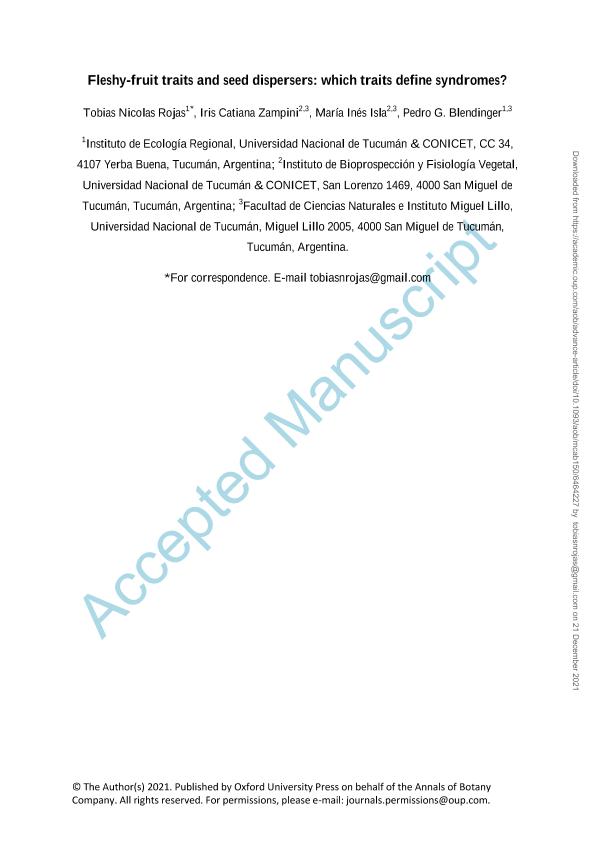Mostrar el registro sencillo del ítem
dc.contributor.author
Rojas, Tobias Nicolas

dc.contributor.author
Zampini, Iris Catiana

dc.contributor.author
Isla, Maria Ines

dc.contributor.author
Blendinger, Pedro Gerardo

dc.date.available
2023-01-11T17:30:23Z
dc.date.issued
2021-12
dc.identifier.citation
Rojas, Tobias Nicolas; Zampini, Iris Catiana; Isla, Maria Ines; Blendinger, Pedro Gerardo; Fleshy-fruit traits and seed dispersers: which traits define syndromes?; Oxford University Press; Annals of Botany; 129; 7; 12-2021; 831-838
dc.identifier.issn
0305-7364
dc.identifier.uri
http://hdl.handle.net/11336/184389
dc.description.abstract
Background and Aims: Fruit traits and their inter-relationships can affect foraging choices by frugivores, and hence the probability of mutualistic interactions. Certain combinations of fruit traits that determine the interaction with specific seed dispersers are known as dispersal syndromes. The dispersal syndrome hypothesis (DSH) states that seed dispersers influence the combination of fruit traits found in fruits. Therefore, fruit traits can predict the type of dispersers with which plant species interact. Here, we analysed whether relationships of fruit traits can be explained by the DSH. To do so, we estimated the inter-relationships between morphological, chemical and display groups of fruit traits. In addition, we tested the importance of each trait group defining seed dispersal syndromes. Methods: Using phylogenetically corrected fruit trait data and fruit-seed disperser networks, we tested the relationships among morphological, chemical and display fruit traits with Pearson's correlations and phenotypic integration indices. Then, we used perMANOVA to test if the fruit traits involved in the analysis supported the functional types of seed dispersers. Key Results: Morphological traits showed strong intragroup relationships, in contrast to chemical and display traits whose intragroup trait relationships were weak or null. Accordingly, only the morphological group of traits supported three broad seed disperser functional types (birds, terrestrial mammals and bats), consistent with the DSH. Conclusions: Altogether, our results give some support to the DSH. Here, the three groups of traits interacted in different ways with seed disperser biology. Broad functional types of seed dispersers would adjust fruit consumption to anatomical limitations imposed by fruit morphology. Once this anatomical filter is sovercome, seed dispersers use almost all the range of variation in chemical and display fruit traits. This suggests that the effect of seed dispersers on fruit traits is modulated by hierarchical decisions. First, morphological constraints define which interactions can actually occur; subsequently, display and composition determine fruit preferences.
dc.format
application/pdf
dc.language.iso
eng
dc.publisher
Oxford University Press

dc.rights
info:eu-repo/semantics/openAccess
dc.rights.uri
https://creativecommons.org/licenses/by-nc-sa/2.5/ar/
dc.subject
ENDOZOOCHORY
dc.subject
FLESHY FRUITS
dc.subject
FRUGIVORY
dc.subject
FRUIT CHEMICAL COMPOSITION
dc.subject
FRUIT COLOUR
dc.subject
FRUIT TRAITS
dc.subject
SEED DISPERSAL SYNDROMES
dc.subject
TRAIT MATCHING
dc.subject.classification
Ecología

dc.subject.classification
Ciencias Biológicas

dc.subject.classification
CIENCIAS NATURALES Y EXACTAS

dc.title
Fleshy-fruit traits and seed dispersers: which traits define syndromes?
dc.type
info:eu-repo/semantics/article
dc.type
info:ar-repo/semantics/artículo
dc.type
info:eu-repo/semantics/publishedVersion
dc.date.updated
2022-04-21T19:18:57Z
dc.journal.volume
129
dc.journal.number
7
dc.journal.pagination
831-838
dc.journal.pais
Reino Unido

dc.journal.ciudad
Oxford
dc.description.fil
Fil: Rojas, Tobias Nicolas. Universidad Nacional de Tucumán. Instituto de Ecología Regional. Consejo Nacional de Investigaciones Científicas y Técnicas. Centro Científico Tecnológico Conicet - Tucumán. Instituto de Ecología Regional; Argentina
dc.description.fil
Fil: Zampini, Iris Catiana. Universidad Nacional de Tucumán. Instituto de Bioprospección y Fisiología Vegetal. Consejo Nacional de Investigaciones Científicas y Técnicas. Centro Científico Tecnológico Conicet Noa Sur. Instituto de Bioprospección y Fisiología Vegetal; Argentina
dc.description.fil
Fil: Isla, Maria Ines. Universidad Nacional de Tucumán. Instituto de Bioprospección y Fisiología Vegetal. Consejo Nacional de Investigaciones Científicas y Técnicas. Centro Científico Tecnológico Conicet Noa Sur. Instituto de Bioprospección y Fisiología Vegetal; Argentina
dc.description.fil
Fil: Blendinger, Pedro Gerardo. Universidad Nacional de Tucumán. Instituto de Ecología Regional. Consejo Nacional de Investigaciones Científicas y Técnicas. Centro Científico Tecnológico Conicet - Tucumán. Instituto de Ecología Regional; Argentina
dc.journal.title
Annals of Botany

dc.relation.alternativeid
info:eu-repo/semantics/altIdentifier/url/https://academic.oup.com/aob/advance-article/doi/10.1093/aob/mcab150/6464227
dc.relation.alternativeid
info:eu-repo/semantics/altIdentifier/doi/http://dx.doi.org/10.1093/aob/mcab150
Archivos asociados
